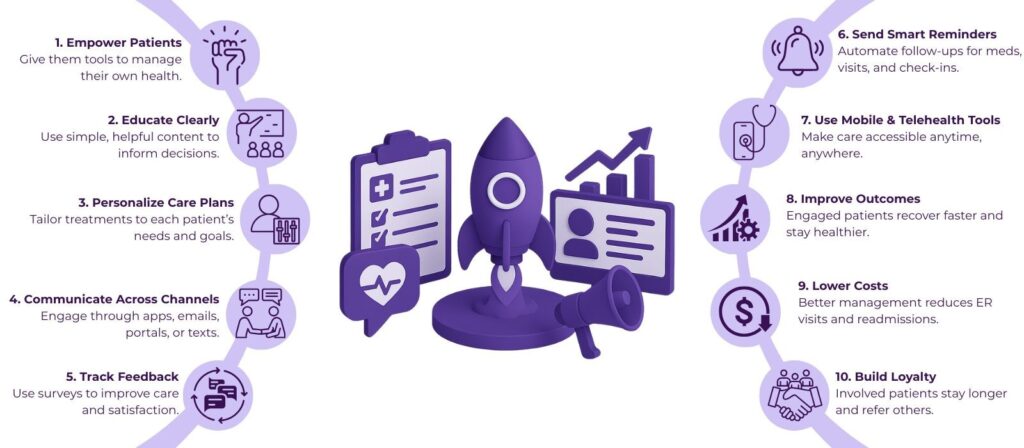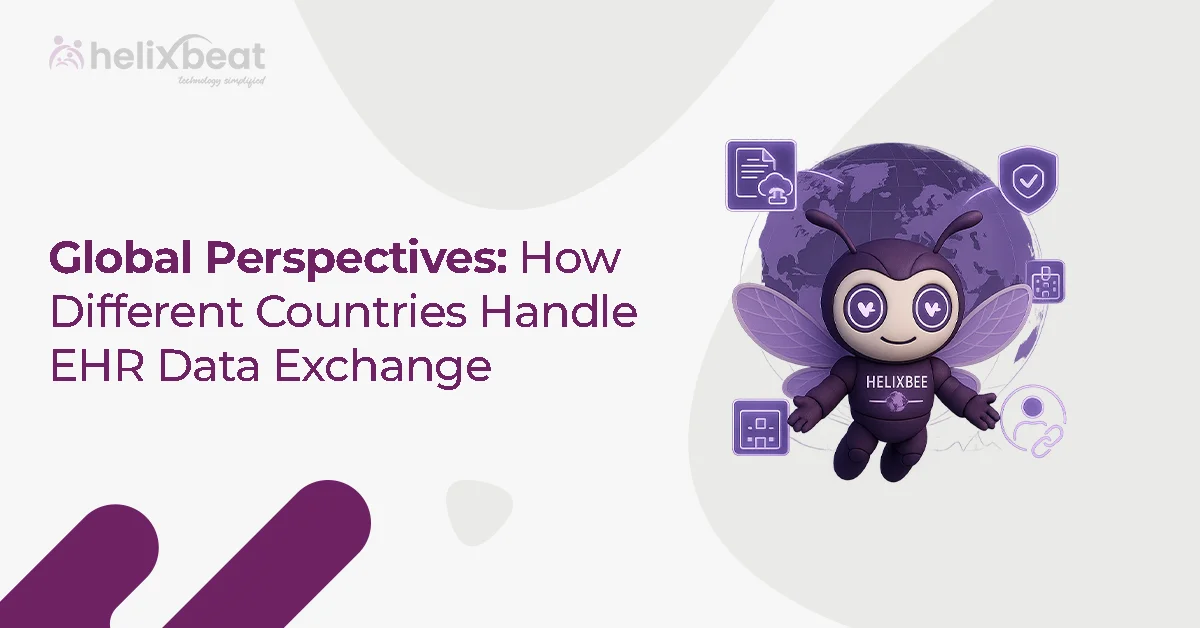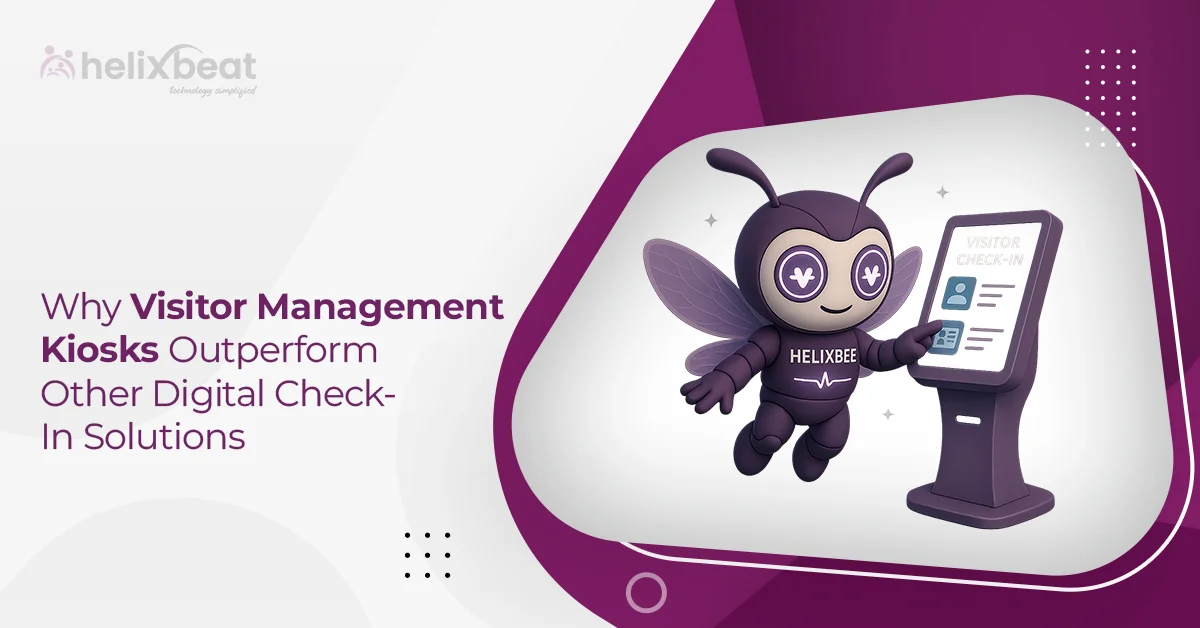What if patients actively participated in their healthcare decisions and treatments, leading to better outcomes and efficiency? This is the core of patient engagement. It involves empowering patients with the tools and information to make informed choices about their care. Engaged patients take an active role in managing their health, resulting in improved outcomes, higher satisfaction, and reduced costs.
By focusing on engaging patients and utilizing digital solutions to streamline interactions, healthcare organizations can create a more proactive and personalized care experience that benefits both patients and providers.

Table of Contents
Understanding Patient Engagement in Healthcare
Patient engagement refers to patients actively participating in their own healthcare decisions. It involves more than just going to the doctor or following treatment plans. Patients should be informed, motivated, and empowered to take an active role in managing their health.
A survey by PwC reveals that 70% of patients want more digital engagement options to communicate with their healthcare providers, highlighting the rising demand for modern solutions. Digital patient engagement uses tools like mobile apps, patient portals, telehealth platforms, automated reminders, and wearable devices to foster continuous interaction between patients and providers.
Key Components of Effective Patient Engagement Solution
Here are the key components of an effective patient engagement solution:
1. Communication & Education
Clear and open communication is the cornerstone of patient engagement. By providing patients with easily accessible, reliable, and relevant information, healthcare providers empower patients to make informed decisions about their care. Education can range from explaining treatment options to providing detailed instructions for managing chronic conditions at home.
How it works:
- Personalized Messaging: Send tailored health reminders, appointment updates, and educational materials that align with the patient’s unique health needs.
- Multichannel Communication: Use various channels such as mobile apps, emails, text messages, and even patient portals to communicate with patients in a way that fits their preferences.
- Proactive Health Education: Offering educational content such as videos, articles, and infographics that help patients understand their conditions and treatment plans.
For instance, Helixbeat PULSE, a powerful patient engagement software, enables seamless communication between healthcare providers and patients. By using PULSE, providers can send automated educational content and personalized health tips, ensuring patients are always informed and engaged in their care.
2. Personalized Care Plans
Personalized care plans are crucial for fostering patient engagement. Each patient is unique, and a one-size-fits-all approach is rarely effective in healthcare. Personalized care plans are tailored to address the specific health needs, preferences, and goals of each patient, ensuring a more patient-centric approach.
How it works:
- Comprehensive Health Assessments: Begin with a thorough evaluation of the patient’s medical history, lifestyle, and current health status to create an individualized care plan.
- Patient Involvement: Involve patients in the decision-making process, ensuring that the care plan is aligned with their values, preferences, and goals. This approach fosters trust and encourages patients to take an active role in their care.
- Dynamic Adjustments: As patients progress, care plans should be regularly updated based on real-time data and feedback to reflect changes in the patient’s condition.
Using Helixbeat PULSE, healthcare providers can monitor patient progress, and send personalized reminders for medication or upcoming appointments, making the entire process smooth and efficient for both patients and providers.
3. Feedback & Patient Satisfaction Tracking
Tracking patient satisfaction and obtaining regular feedback are integral to improving healthcare delivery and patient engagement. Feedback allows healthcare providers to gauge patient sentiment, identify areas for improvement, and make necessary adjustments to care strategies.
How it works:
- Patient Surveys: Collect real-time feedback through surveys sent post-appointment or after treatment is completed. Questions should focus on aspects such as the quality of care, communication with the provider, and overall satisfaction.
- Real-Time Monitoring: Implement systems that track patient satisfaction during care delivery, allowing for immediate improvements if issues arise.
- Actionable Insights: Use patient feedback to improve future interactions and services, ultimately leading to higher patient retention and satisfaction.
How Do You Encourage Patient Engagement?
Fostering patient involvement is crucial for achieving better health outcomes and patient satisfaction. It entails strategies that encourage patients to take an active role in their care. Here’s how healthcare providers can foster stronger patient engagement:
1. Clear and Transparent Communication
Use simple, jargon-free language to explain diagnoses, treatment options, and care plans. Patients feel more confident and involved when they understand their health information.
2. Personalized Care Approaches
Tailor health interventions and follow-ups based on individual patient needs, preferences, and lifestyle to increase relevance and motivation.
3. Interactive Education
Provide educational materials such as videos, brochures, and online resources that encourage patients to learn about their conditions and treatment choices.
4. Regular Follow-ups and Reminders
Automated appointment reminders, medication alerts, and check-ins help patients stay on track with their care plans.
5. Encourage Feedback and Patient Voice
Actively seek patient feedback through surveys or direct conversations to address concerns and improve care experiences.
Role of Technology & Digital Patient Engagement Tools
Here are some key technological solutions shaping patient engagement today:
Patient Portals
- These secure online platforms allow patients to easily access their medical records, view test results, communicate directly with healthcare providers, and manage appointments, all from the comfort of their homes.
- Patient portals streamline communication and help patients stay informed about their health status.
Mobile Health Apps
- Mobile apps are powerful tools for engaging patients beyond the clinic.
- They can track symptoms, medication schedules, physical activity, and lifestyle habits.
- By providing real-time feedback and reminders, these apps promote adherence and encourage patients to actively participate in their care journey.
Telehealth Solutions
- Virtual consultations through telehealth platforms increase accessibility by removing geographical and logistical barriers.
- Patients can connect with providers conveniently, fostering regular follow-ups and timely interventions, which improves overall engagement and health outcomes.
AI-Powered Chatbots
- Available 24/7, AI chatbots offer instant responses to common patient questions and concerns.
- They guide patients through symptom checking, appointment scheduling, and provide educational resources, enhancing engagement even outside of normal clinical hours.
Benefits of Using Patient Engagement Software
Despite the challenges, patient engagement offers numerous advantages for both patients and healthcare organizations.
Improved Health Outcomes
Engaged patients are more likely to:
- Adhere to prescribed treatment plans and medications as directed.
- Attend follow-up appointments and screenings.
- Follow preventive measures, such as vaccination schedules and lifestyle changes.
- Reduced hospitalization rates and emergency room visits.
- Fewer complications for chronic conditions like diabetes, heart disease, and hypertension.
- Enhanced overall well-being and disease management.
Enhanced Patient Experience
Builds a more collaborative relationship between patients and healthcare providers
- Fosters trust and transparency in healthcare interactions.
- Encourages patients to express concerns and make informed decisions about their care.
- Patients feel more supported and involved in their healthcare journey.
- Confident in their treatment plans and decisions.
Reduced Healthcare Costs
Engaged patients are more likely to:
- Adhere to treatment regimens to reduce the likelihood of complications.
- Prevent disease progression, lowering the need for costly interventions.
- Reduced emergency visits and hospitalizations.
- Fewer readmissions due to better management of chronic conditions.
Increased Patient Satisfaction and Loyalty
When patients are involved in their healthcare decisions, they experience:
- Higher satisfaction levels due to feeling empowered and informed.
- Greater trust in their healthcare providers.
- Engaged patients are more likely to return for future care and recommend providers to others.
- Loyal to providers who offer transparent, personalized care.
Better Communication and Collaboration
Patient engagement tools (e.g., patient portals, mobile apps) enable:
- Clear, ongoing communication between patients and healthcare providers.
- Easy access to health records, appointment reminders, and progress tracking.
- Improved care coordination, especially in multi-provider care scenarios.
- Timely updates about symptoms, medications, and overall health.
Choosing the Right Patient Engagement Solution for Your Healthcare Organization
Here’s what to consider when choosing patient engagement software:
Features to Look for in Patient Engagement Software
- Multi-Channel Communication: Look for platforms that support SMS, email, phone calls, and in-app messaging to engage patients through their preferred channels of communication.
- Appointment Scheduling & Reminders: Automated booking and reminder features reduce no-shows and keep patients informed.
- Patient Education: The solution should provide personalized educational content to empower patients with information about their health conditions and treatment plans.
- Feedback Collection: Built-in tools for surveys and satisfaction tracking help you understand patient needs and enhance service delivery.
- User-Friendly Interface: Both patients and staff should find the software intuitive and easy to navigate.
- Analytics & Reporting: Real-time dashboards and detailed reports provide insights into patient engagement effectiveness and operational performance.
Security & Compliance Considerations
- HIPAA Compliance: Ensure the software meets all applicable HIPAA regulations to protect patient privacy and data security.
- Data Encryption: End-to-end encryption safeguards sensitive patient information during transmission and storage.
- Access Controls: Role-based access ensures that only authorized personnel can view or modify patient data.
Final Insights
The influence of patient engagement on healthcare growth is significant. When patients are involved in their care, providers achieve better outcomes, enhanced efficiency, and increased loyalty. Advanced patient engagement solutions help organizations foster communication, personalized care, and secure patient information, essential elements of patient-centered healthcare.
Helixbeat’s patient engagement platform transforms healthcare practices by integrating effective communication tools and robust data security, enabling stronger patient connections, improved satisfaction, and better health outcomes. Book a demo or register for a free trial of Helixbeat’s patient engagement solution now!
FAQs
- How Important Is Patient Engagement in Healthcare?
Patient engagement is vital as it leads to better health outcomes, increased treatment adherence, and improved patient satisfaction. Engaged patients are more informed and proactive about their care, which reduces complications and healthcare costs.
- How Do You Encourage Patient Engagement?
Encourage patient engagement by fostering open communication, providing easy access to health information, using digital tools like patient portals or apps, and involving patients in decision-making about their care.
- Which Action Best Promotes Patient Engagement?
The best action to promote patient engagement is encouraging two-way communication between patients and providers, ensuring patients feel heard, supported, and involved throughout their healthcare journey.
- What Does Engagement Mean in Healthcare?
In healthcare, engagement refers to the active participation of patients in their own care, including understanding their health conditions, following treatment plans, and collaborating with healthcare providers to make informed decisions.














